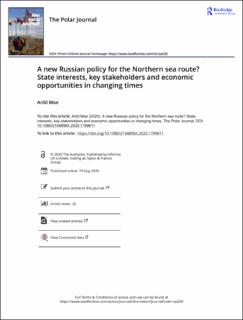| dc.contributor.author | Moe, Arild | |
| dc.date.accessioned | 2020-08-24T10:48:30Z | |
| dc.date.available | 2020-08-24T10:48:30Z | |
| dc.date.created | 2020-08-19T15:49:46Z | |
| dc.date.issued | 2020 | |
| dc.identifier.citation | The Polar Journal. 2020, . | |
| dc.identifier.issn | 2154-896X | |
| dc.identifier.uri | https://hdl.handle.net/11250/2673590 | |
| dc.description.abstract | The 2013 NSR regime was explicitly aimed at attracting international users and transit shipping, but recent Russian policies point in a different direction. Expectations of a rapid increase in transit shipping have faded, whereas promoting the swift development of destination shipping serving large resource extraction projects has become a top political priority. Security concerns have become more pronounced, but have not impacted commercial shipping activity noticeably. There are tensions between the ambitions for increased output of minerals and the extensive protectionist measures which have been introduced, but, with one prominent exception, industrial stakeholders seem content with less-competitive shipping arrangements. The 2013 regulatory regime was designed to serve individual voyages. The new developments centre around large extractive projects with individual logistical solutions – including special conditions negotiated with the authorities. The NSR administration has undergone significant change, with a dominant role accorded to the state nuclear energy corporation Rosatom – itself engaged in commercial activities. The room for foreign shipping interests has shrunk, but not disappeared. Their opportunities will depend on alliances with key Russian players. | |
| dc.language.iso | eng | |
| dc.relation.uri | https://www.tandfonline.com/doi/full/10.1080/2154896X.2020.1799611 | |
| dc.subject | Arktis | |
| dc.subject | Arctic | |
| dc.subject | Skipsfartspolitikk | |
| dc.subject | Shipping policy | |
| dc.subject | Russland | |
| dc.subject | Russia | |
| dc.title | A new Russian policy for the Northern sea route? State interests, key stakeholders and economic opportunities in changing times | |
| dc.type | Peer reviewed | |
| dc.type | Journal article | |
| dc.description.version | publishedVersion | |
| dc.subject.nsi | VDP::Statsvitenskap og organisasjonsteori: 240 | |
| dc.subject.nsi | VDP::Political science and organisational theory: 240 | |
| dc.source.pagenumber | 19 | |
| dc.source.journal | The Polar Journal | |
| dc.identifier.doi | 10.1080/2154896X.2020.1799611 | |
| dc.identifier.cristin | 1824124 | |
| dc.relation.project | Fridtjof Nansens institutt: 469 | |
| dc.relation.project | Norges forskningsråd: 287576 | |
| cristin.ispublished | true | |
| cristin.fulltext | original | |
| cristin.qualitycode | 1 | |
